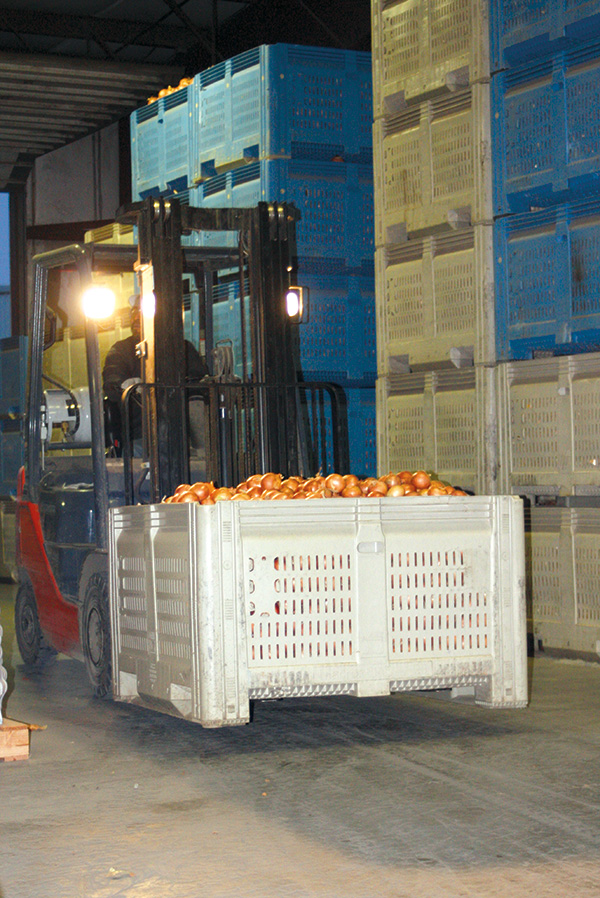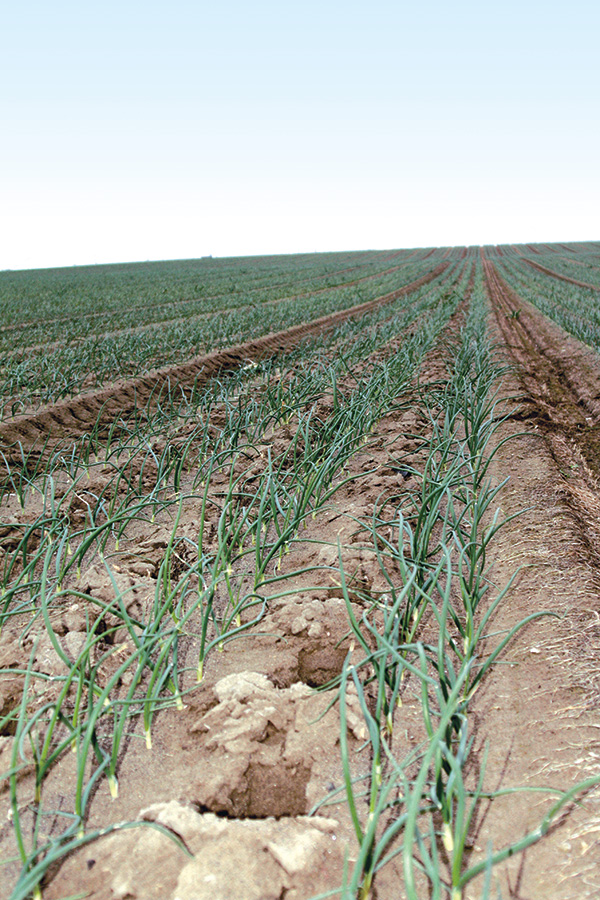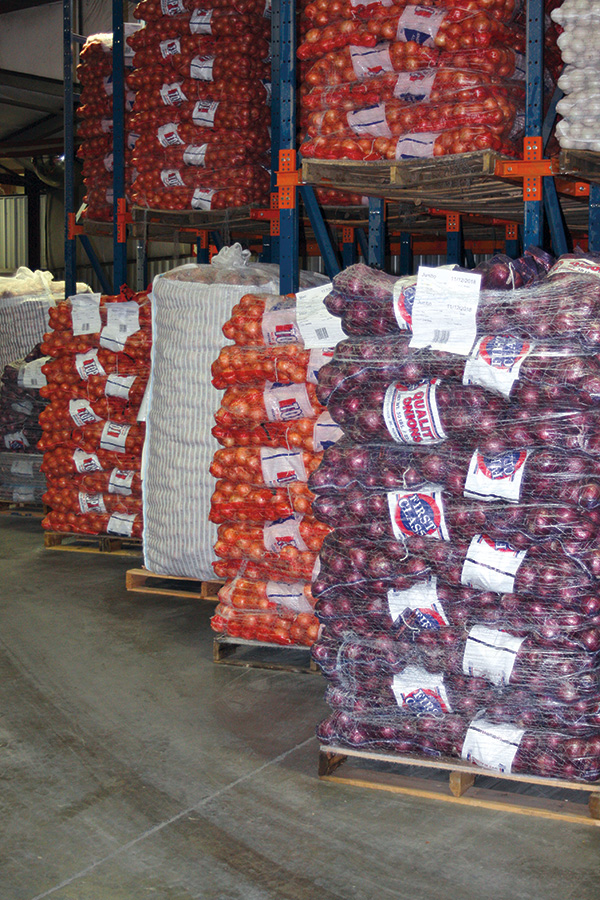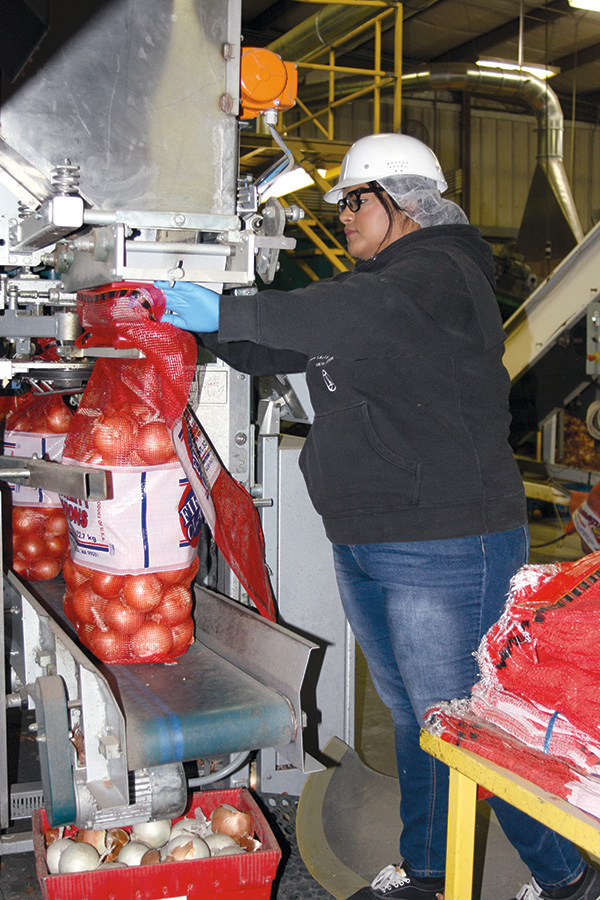Story and photos by Denise Keller, Editor

As most onion growers know, quality is key. For CSS Farms in Pasco, Washington, consistently growing a quality crop starts from the ground up, with soil health being a top priority for the farm. CSS utilizes several soil management practices to produce the consistent quality needed to compete in the Columbia Basin.
“There are so many onions to choose from in the Basin that you have to be at the highest level, or I think you’re going to struggle with the market,” says CSS onion grower Cody Nickoloff. “Quality is everything. If you don’t have quality, you don’t have anything.”
Among the biggest growing challenges for the farm is water infiltration. Decades of onion production and heavy cultivation of the ground have resulted in a fine sediment that settles during irrigation, creating a hardpan 6 inches down, Nickoloff says. He is working to correct tillage practices to incorporate more matter into the ground and minimize plowing so that the sediment won’t be so fine.
CSS currently uses a mini-pitter to aerate the soil. The equipment creates small reservoirs about 6 to 8 inches deep between each double row. The grower runs the pitter through every square inch of onion ground two or three times each season, beginning when onions reach the two-leaf stage. The process increases water holding capacity and prevents washout of sloped fields. It also helps oxygen get down to the roots and allows fertilizer to penetrate through the bed to the root zone instead of leaching off to the side of the bed.
Nickoloff also sees some soil health benefits from the farm’s variable rate applications of compost each fall. The program has helped increase the capacity of weaker soil to hold nutrients and water, which in turn, improves the health of onion plants.

Early-Market Grower
In addition to a focus on quality, CSS Farms takes advantage of timing to compete in the market. The farm is one of the first in the Basin to plant and harvest onions each year, according to Nickoloff. When other growers are finishing the previous year’s storage crop, CSS has some of the first new-year crop coming out of the field, allowing the farm to find a place in the early market.
CSS Farms grows between 1,500 and 2,000 acres of onions for the fresh market. Acreage includes overwinter onions, spring-planted summer onions and a storage crop. The storage yellow onions are the farm’s big production push, with reds and whites filling in to meet market demands. Late-season yellows are mostly made up of Legend, Crockett and Hamilton, with Redwing used as the farm’s main late-season red variety and Ice Pearl as the primary main-season white. The farm also grows some sweet onions, including Calibra and a pair of numbered varieties. In addition to onions, CSS Farms grows potatoes, as well as rotations of seed corn, sweet corn and grain sorghum.
CSS packs its onions, chip potatoes and table-stock potatoes at Agri-Pack, a subsidiary of CSS Farms. The Pasco packing shed packs more than 150 million pounds of onions each year, according to plant manager Ken Rutledge. Onions are shipped domestically and to customers in Canada, Mexico, Europe and Asia.
The concern for quality carries over from the field into the packing shed. The greatest difficulty in operating an onion packing shed is overcoming the temperature differentials between the air and the onions, Rutledge says.
“Because onions condense moisture similar to a glass of ice water on a summer day, the ability to manage temperature and humidity levels becomes difficult any time we have to pack in extreme heat or extreme cold,” Rutledge explains. “The best way to control this is with moving air. We have fans everywhere on walls and ceilings moving air constantly.”

Field Challenges
Similarly, efforts are made in the field to produce a healthy crop. Using drip irrigation on only 200 acres of the farm’s onions leaves the majority under center pivot irrigation. This requires careful irrigation management to prevent the development of diseases such as Botrytis neck rot, Nickoloff says.
“It’s an art to finish an onion under a pivot,” he adds.
Pink root and Fusarium pressure also needs to be managed. In addition, thrips are a constant challenge, the extent of which varies year to year. With few effective products available to control thrips, scouting is the best defense, Nickoloff says. The farm also cooperates with Washington State University researchers in trials of new chemistries.
Last year, the farm added peroxyacetic acid Jet-Ag to its program. Nickoloff says it’s been a game changer in his fungicide rotation. He begins applications at the five-leaf stage, and then runs it through the pivot weekly to kill bacteria. He has been trialing the product on downy mildew, black mold and white mold, and has seen good results. CSS also uses the product to sanitize onion storage facilities.

High-Risk Crop
The farm’s 120-acre overwinter onion crop presents a challenge all its own. Although the crop is grown in an area of the Basin with slightly warmer winter temperatures, weather can still wreak havoc on the crop.
“On overwinter onions, most growers live by the motto that one in every four years you’re going to make it,” Nickoloff notes, explaining that bolting is most often the crop’s demise. “But if you do make it, on a good year, you make up quite a bit of return.”
Ideally, snow acts as a blanket to protect bulbs from freezing during the winter, and temperatures warm up steadily in the spring. Often, however, a hard freeze in early spring triggers plants to shift resources from bulb development to reproduction, and bolting occurs.
The crop is typically planted in September and harvested in June. When choosing a planting date, Nickoloff considers the next month’s weather, wanting onions to reach the three- or four-leaf stage before going dormant for the winter.

Farming Lifestyle
It’s the many challenges of growing onions that Nickoloff enjoys most.
“If everything was easy, it would be boring, right?” the grower points out. “I like the challenge. Every day, I have to keep my crop alive and do the best I can do for that crop. If I don’t, it’s easy to lose a lot of money really quickly.”
Nickoloff oversees CSS Farms’ onion production from ordering seed to managing fertility to harvesting the crop. He’s been with the farm for three years. He grew up nearby, in the Yakima Valley, working on his family’s fruit farm. Wanting out of agriculture, he went to work on the railroad, but missed being outside farming. He landed a job at Carr Farms shortly before it was purchased by CSS Farms in 2016.
“When I came back and got the opportunity to farm again, I realized how much I missed it,” Nickoloff reflects. “It’s a passion; it’s a lifestyle. It’s not a job.”

